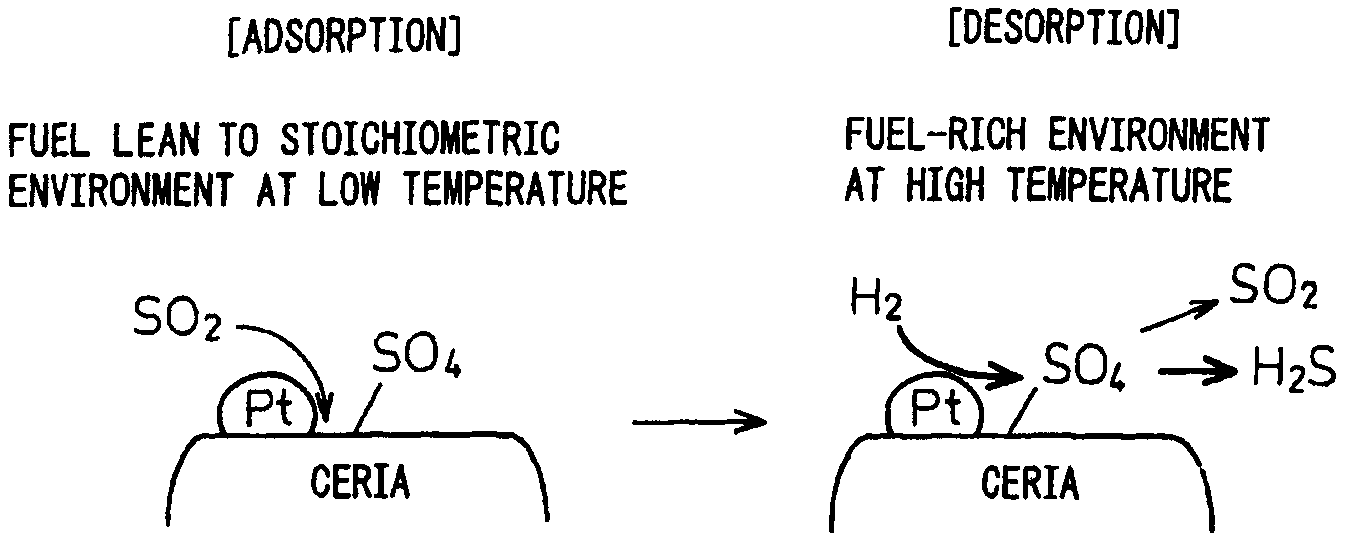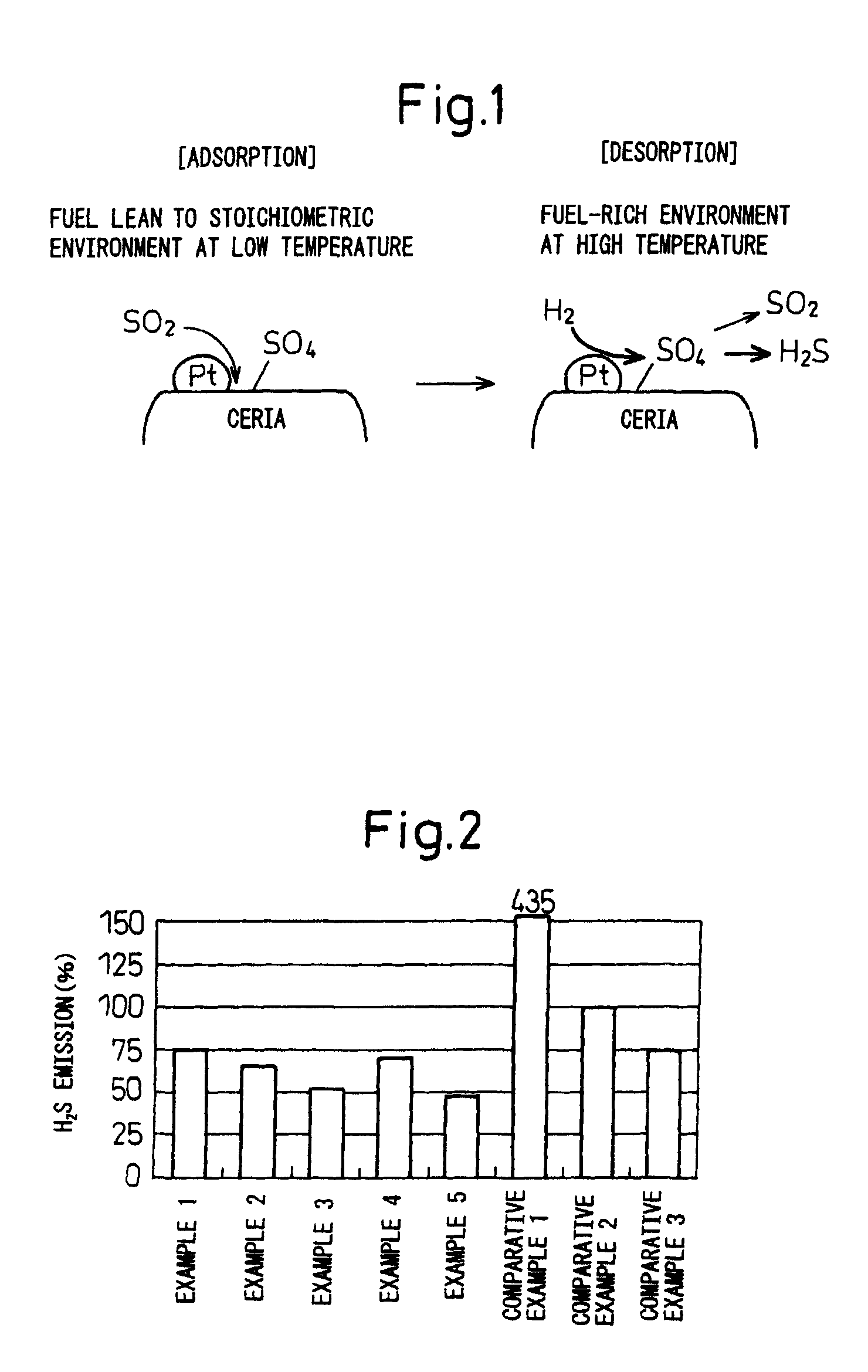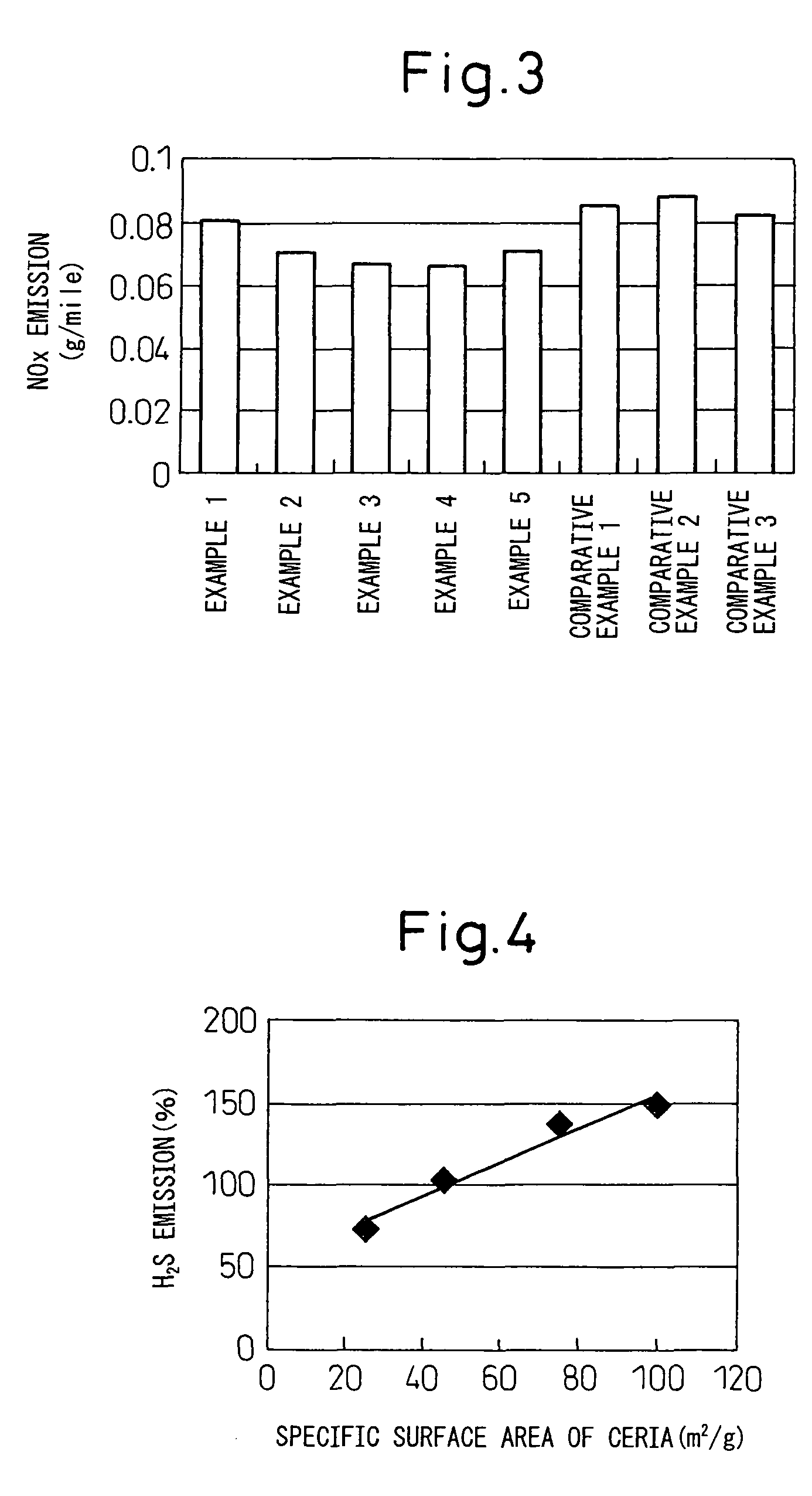Catalyst for purifying exhaust gas
a technology of exhaust gas and catalyst, which is applied in the direction of metal/metal-oxide/metal-hydroxide catalyst, machine/engine, arsenic compound, etc., can solve the problem of not being able to use catalysts, achieve the same exhaust gas purification performance, and reduce the effect of hydrogen sulfide emission
- Summary
- Abstract
- Description
- Claims
- Application Information
AI Technical Summary
Benefits of technology
Problems solved by technology
Method used
Image
Examples
example 1
[0025]A palladium nitrate solution (containing about 0.5 g of palladium) was combined with 40 g of alumina, 52 g of ceria with surface area of 25 m2 / g, and 60 g of alumina sol (10 wt %) to prepare slurry 1. Separately, slurry 2 was prepared by combining a solution made by dissolving platinum in nitric acid (hereinafter referred to as “platinum nitrate solution”: containing about 0.5 g of platinum), 60 g of alumina, and 40 g of alumina sol (10 wt %).
[0026]A monolith honeycomb type of base material (volume of 1 L) was coated with slurry 1, dried at 150° C. for one hour, and fired at 500° C. for one hour to prepare a lower layer. The catalyst according to the present invention (the catalyst of Example 1) was prepared by top coating the lower layer with slurry 2, drying it at 150° C. for one hour, and then firing it at 500° C. for one hour. The composition of the catalyst of Example 1 was as follows:
[0027]The upper layer: platinum, 0.5 g / L, rhodium, 0.2 g / L, alumina, 64 g / L;
[0028]The lo...
example 2
[0029]A platinum nitrate solution (containing about 0.2 g of platinum) was combined with 40 g of alumina, 52 g of ceria with surface area of 25 m2 / g, and 60 g of alumina sol (10 wt %) to prepare slurry 3. Separately, slurry 4 was prepared by combining a platinum nitrate solution (containing about 0.8 g of platinum), a rhodium nitrate solution (containing about 0.2 g of rhodium), 60 g of alumina, and 40 g of alumina sol (10 wt %).
[0030]The catalyst of the present invention (the catalyst of Example 2) was prepared by using slurry 3 for the lower layer and slurry 4 for the upper layer according to the procedure of Example 1. The composition of the catalyst of Example 2 was as follows:
[0031]The upper layer: platinum, 0.8 g / L, rhodium, 0.2 g / L, alumina, 64 g / L;
[0032]The lower layer: platinum, 0.2 g / L, alumina, 46 g / L, ceria 52 g / L.
example 3
[0033]A platinum nitrate solution (containing about 0.2 g of platinum) was combined with 50 g of alumina, 52 g of ceria with surface area of 25 m2 / g, 8.4 g of neodymium oxide, and 50 g of alumina sol (10 wt %) to prepare slurry 5. Separately, slurry 6 was prepared by combining a platinum nitrate solution (containing about 0.8 g of platinum), a rhodium nitrate solution (containing about 0.2 g of rhodium), 50 g of alumina, 37 g of zirconium oxide and 50 g of alumina sol (10 wt %).
[0034]The catalyst of the present invention (the catalyst of Example 3) was prepared by using slurry 5 for the lower layer and slurry 6 for the upper layer according to the procedure of Examples 1 and 2. The composition of the catalyst of Example 3 was as follows:
[0035]The upper layer: platinum, 0.8 g / L, rhodium, 0.2 g / L, alumina, 55 g / L, zirconia, 37 g / L;
[0036]The lower layer: platinum, 0.2 g / L, alumina, 55 g / L, ceria 52 g / L, neodymium oxide, 8.4 g / L.
PUM
| Property | Measurement | Unit |
|---|---|---|
| specific surface area | aaaaa | aaaaa |
| specific surface area | aaaaa | aaaaa |
| volume | aaaaa | aaaaa |
Abstract
Description
Claims
Application Information
 Login to View More
Login to View More - R&D
- Intellectual Property
- Life Sciences
- Materials
- Tech Scout
- Unparalleled Data Quality
- Higher Quality Content
- 60% Fewer Hallucinations
Browse by: Latest US Patents, China's latest patents, Technical Efficacy Thesaurus, Application Domain, Technology Topic, Popular Technical Reports.
© 2025 PatSnap. All rights reserved.Legal|Privacy policy|Modern Slavery Act Transparency Statement|Sitemap|About US| Contact US: help@patsnap.com



